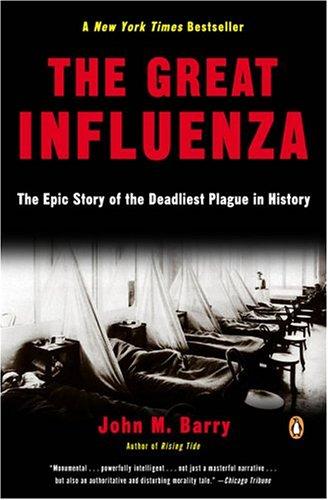 The Great Influenza by John M. Barry is a fascinating look at the influenza pandemic that rocked the world in 1918. This terrifying virus killed between 3-6% of the world’s population between June 1918 and December 1920, and infected almost 30%. It is a history book, but it is heavy in the science. It is a thoroughly detailed book, providing information and statistics from around the globe during the outbreak, although the book gives the most time to those in the United States.
The Great Influenza by John M. Barry is a fascinating look at the influenza pandemic that rocked the world in 1918. This terrifying virus killed between 3-6% of the world’s population between June 1918 and December 1920, and infected almost 30%. It is a history book, but it is heavy in the science. It is a thoroughly detailed book, providing information and statistics from around the globe during the outbreak, although the book gives the most time to those in the United States.
The perspective of The Great Influenza is primarily one of American citizens and cities and American scientists and doctors. It is set in the backdrop of the country’s transition to “modern medicine” from the period of home remedies and folk cures. A large portion of the early book is focused on laying a foundation for the tale of the pandemic by giving a detailed look at American medical history. I found this section of the book interesting and enjoyed the overlap it had with several books I’d recently read from the same time period, but I can see how one might find it extraneous to the story.
Once you are past the more dry sections of the book, The Great Influenza reads very much like a suspense thriller – because it was. Pandemics are already scary by nature, and this book is no help to that fear. There are so many levels of concern: From the nature of the lethal virus itself, to the reactions of the politicians who were more worried about worrying people than saving them, to the total ineffectiveness of most measures taken to stop the spread. The result is fascinating, but chilling.
The book also contained a lot of information that people might not have been aware of. Just as an example, I always remember being told that the reason the virus killed so many healthy young adults was because it was primarily confined to the military populations for the Great War. I’m sure others have heard similar things. While it is true that the War greatly aggravated the spread on many fronts, a major reason why so many young and healthy died is because the virus causes something called cytokine storm which is an overreaction of the immune system. For this reason, the people with the healthiest immune systems often ended up facing the most lethal symptoms, as their systems went into overdrive and killed them.
The rest of the book is devoted to the scientists and doctors who dedicated their lives during the pandemic to its cause. Discovering the nature of the virus, its causes, how it was spread, why it was so deadly, and how to stop it was a unifying goal for many of these people. The Great Influenza tells their individual and collective stories, and discusses the work they did and any insight they were able to shine on the pandemic that was devastating the world. The book is not just about how the flu impacted the world, but how the world impacted the flu.
Overall, the book is extremely well-researched and covers a huge scope of history, politics, and medical science for many decades. It is apparent that Barry put in a tireless effort to provide us with a thorough and informative book. It is absolutely worth reading not just for the story of the 1918 influenza, but also because of the illumination it provides on how the world should (and shouldn’t) handle future pandemics.
